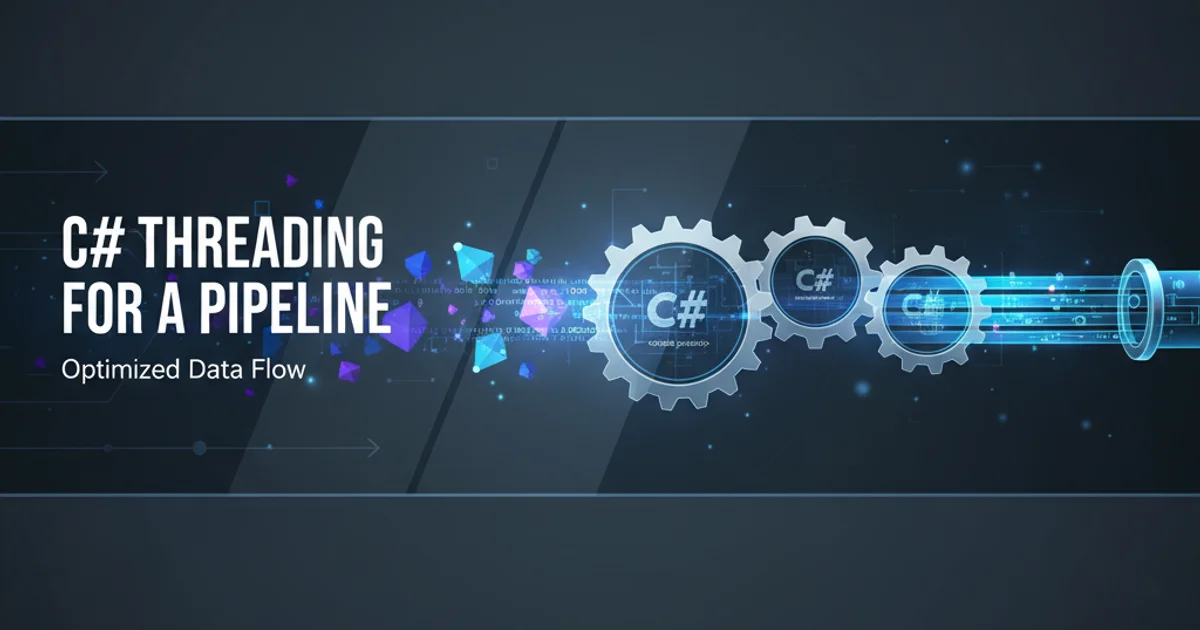C# Threading for a pipeline
Categories:
Mastering C# Threading for High-Performance Data Pipelines

Explore how to design and implement efficient, scalable data pipelines in C# using multithreading techniques to process data concurrently and improve throughput.
In modern applications, especially those dealing with large volumes of data or complex computations, sequential processing often becomes a bottleneck. C# offers robust multithreading capabilities that can be leveraged to build high-performance data pipelines. A data pipeline typically involves a series of stages where data is transformed or processed. By executing these stages concurrently, or by processing multiple data items simultaneously within a stage, we can significantly improve an application's responsiveness and throughput.
Understanding the Pipeline Architecture
A multithreaded pipeline breaks down a complex task into smaller, independent stages. Each stage can operate on data as soon as it becomes available from the previous stage, often in parallel with other stages. This 'assembly line' approach minimizes idle time and maximizes resource utilization. Common stages include data ingestion, parsing, transformation, validation, and storage.
flowchart TD
A[Data Source] --> B{Stage 1: Ingestion}
B --> C{Stage 2: Processing}
C --> D{Stage 3: Transformation}
D --> E{Stage 4: Validation}
E --> F[Data Sink]
subgraph Concurrent Processing
B -- Parallel --> B1(Worker 1)
B -- Parallel --> B2(Worker 2)
B -- Parallel --> Bn(Worker N)
end
subgraph Pipelined Flow
B --> C
C --> D
D --> E
end
style B fill:#f9f,stroke:#333,stroke-width:2px
style C fill:#bbf,stroke:#333,stroke-width:2px
style D fill:#fbf,stroke:#333,stroke-width:2px
style E fill:#bfb,stroke:#333,stroke-width:2pxConceptual diagram of a multi-stage data pipeline with concurrent processing within a stage.
Implementing Pipeline Stages with BlockingCollection<T>
One of the most effective ways to implement a producer-consumer pattern for pipeline stages in C# is using BlockingCollection<T>. This thread-safe collection allows producers to add items and consumers to take items, automatically handling synchronization and blocking when the collection is empty or full. This simplifies the coordination between pipeline stages significantly.
using System;
using System.Collections.Concurrent;
using System.Threading;
using System.Threading.Tasks;
public class DataPipeline
{
private BlockingCollection<string> _stage1Queue = new BlockingCollection<string>(10);
private BlockingCollection<string> _stage2Queue = new BlockingCollection<string>(10);
private BlockingCollection<string> _stage3Queue = new BlockingCollection<string>(10);
public void StartPipeline()
{
// Stage 1: Producer (e.g., data ingestion)
Task.Run(() => ProducerStage());
// Stage 2: Processor
Task.Run(() => ProcessingStage());
// Stage 3: Consumer (e.g., data storage)
Task.Run(() => ConsumerStage());
Console.WriteLine("Pipeline started. Press any key to stop...");
Console.ReadKey();
// Signal completion and wait for queues to drain
_stage1Queue.CompleteAdding();
// Wait for stages to complete processing
Task.Delay(1000).Wait(); // Give some time for processing to finish
_stage2Queue.CompleteAdding();
Task.Delay(1000).Wait();
_stage3Queue.CompleteAdding();
}
private void ProducerStage()
{
try
{
for (int i = 0; i < 20; i++)
{
string data = $"DataItem_{i}";
_stage1Queue.Add(data);
Console.WriteLine($"Produced: {data}");
Thread.Sleep(100); // Simulate work
}
}
finally
{
_stage1Queue.CompleteAdding();
Console.WriteLine("Producer Stage: Finished adding items.");
}
}
private void ProcessingStage()
{
try
{
foreach (var item in _stage1Queue.GetConsumingEnumerable())
{
string processedData = item.ToUpper(); // Simulate processing
_stage2Queue.Add(processedData);
Console.WriteLine($"Processed: {item} -> {processedData}");
Thread.Sleep(150); // Simulate work
}
}
finally
{
_stage2Queue.CompleteAdding();
Console.WriteLine("Processing Stage: Finished processing items.");
}
}
private void ConsumerStage()
{
try
{
foreach (var item in _stage2Queue.GetConsumingEnumerable())
{
string consumedData = $"Stored_{item}"; // Simulate consumption/storage
_stage3Queue.Add(consumedData);
Console.WriteLine($"Consumed/Stored: {item}");
Thread.Sleep(200); // Simulate work
}
}
finally
{
_stage3Queue.CompleteAdding();
Console.WriteLine("Consumer Stage: Finished consuming items.");
}
}
public static void Main(string[] args)
{
new DataPipeline().StartPipeline();
Console.WriteLine("Pipeline execution complete.");
}
}
A basic C# data pipeline using BlockingCollection<T> for inter-stage communication.
BlockingCollection<T>, always call CompleteAdding() on the producer side once all items have been added. This signals to consumers that no more items will arrive, allowing them to exit their GetConsumingEnumerable() loops gracefully.Scaling and Error Handling
To scale a pipeline, you can introduce multiple consumers for a single BlockingCollection<T> queue. For example, multiple ProcessingStage tasks could consume from _stage1Queue concurrently. This allows horizontal scaling within a stage. Error handling is crucial; consider using try-catch blocks within each stage's task to log exceptions and decide whether to stop the pipeline or continue processing, perhaps by skipping the problematic item.
using System;
using System.Collections.Concurrent;
using System.Threading;
using System.Threading.Tasks;
public class ScalableDataPipeline
{
private BlockingCollection<string> _inputQueue = new BlockingCollection<string>(20);
private BlockingCollection<string> _outputQueue = new BlockingCollection<string>(20);
public void StartPipeline(int numberOfProcessors)
{
// Producer
Task.Run(() => Producer());
// Multiple Consumers (Processors)
for (int i = 0; i < numberOfProcessors; i++)
{
int processorId = i;
Task.Run(() => Processor(processorId));
}
// Final Consumer
Task.Run(() => FinalConsumer());
Console.WriteLine($"Pipeline started with {numberOfProcessors} processors. Press any key to stop...");
Console.ReadKey();
_inputQueue.CompleteAdding();
// Wait for all processors to finish
Task.Delay(numberOfProcessors * 200).Wait(); // Adjust wait time as needed
_outputQueue.CompleteAdding();
}
private void Producer()
{
try
{
for (int i = 0; i < 50; i++)
{
string data = $"RawData_{i}";
_inputQueue.Add(data);
Console.WriteLine($"[Producer] Added: {data}");
Thread.Sleep(50);
}
}
finally
{
_inputQueue.CompleteAdding();
Console.WriteLine("[Producer] Finished adding items.");
}
}
private void Processor(int id)
{
try
{
foreach (var item in _inputQueue.GetConsumingEnumerable())
{
try
{
if (item.Contains("13")) // Simulate an error condition
{
throw new InvalidOperationException($"Error processing item: {item}");
}
string processedItem = $"ProcessedBy{id}_{item.ToLower()}";
_outputQueue.Add(processedItem);
Console.WriteLine($"[Processor {id}] Processed: {item} -> {processedItem}");
Thread.Sleep(100);
}
catch (Exception ex)
{
Console.Error.WriteLine($"[Processor {id}] Error: {ex.Message}");
// Optionally, log the error and/or add to an error queue
}
}
}
finally
{
Console.WriteLine($"[Processor {id}] Finished processing.");
}
}
private void FinalConsumer()
{
try
{
foreach (var item in _outputQueue.GetConsumingEnumerable())
{
Console.WriteLine($"[FinalConsumer] Consumed: {item}");
Thread.Sleep(75);
}
}
finally
{
Console.WriteLine("[FinalConsumer] Finished consuming.");
}
}
public static void Main(string[] args)
{
new ScalableDataPipeline().StartPipeline(3); // Start with 3 parallel processors
Console.WriteLine("Scalable Pipeline execution complete.");
}
}
An example demonstrating a scalable pipeline with multiple parallel processors and basic error handling.